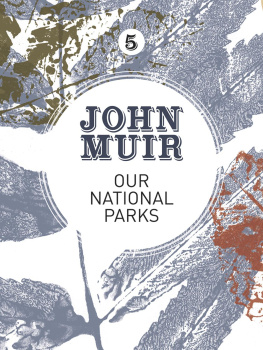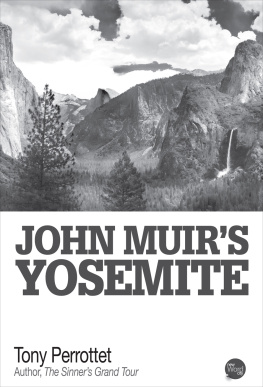
Chapter 24
THE GRAND CANYON OF THE COLORADO
Happy nowadays is the tourist, with earths wonders, new and old, spread invitingly open before him, and a host of able workers as his slaves making everything easy, padding plush about him, grading roads for him, boring tunnels, moving hills out of his way, eager, like the Devil, to show him all the kingdoms of the world and their glory and foolishness, spiritualizing travel for him with lightning and steam, abolishing space and time and almost everything else. Little children and tender, pulpy people, as well as storm-seasoned explorers, may now go almost everywhere in smooth comfort, cross oceans and deserts scarce accessible to fishes and birds, and, dragged by steel horses, go up high mountains, riding gloriously beneath starry showers of sparks, ascending like Elijah in a whirlwind and chariot of fire.
First of the wonders of the great West to be brought within reach of the tourist were the Yosemite and the Big Trees, on the completion of the first transcontinental railway; next came the Yellowstone and icy Alaska, by the northern roads; and last the Grand Canyon of the Colorado, which, naturally the hardest to reach, has now become, by a branch of the Santa Fe, the most accessible of all.
Of course, with this wonderful extension of steel ways through our wildness there is loss as well as gain. Nearly all railroads are bordered by belts of desolation. The finest wilderness perishes as if stricken with pestilence. Bird and beast people, if not the dryads, are frightened from the groves. Too often the groves also vanish, leaving nothing but ashes. Fortunately, nature has a few big places beyond mans power to spoil the ocean, the two icy ends of the globe, and the Grand Canyon.
When I first heard of the Santa Fe trains running to the edge of the Grand Canyon of Arizona, I was troubled with thoughts of the disenchantment likely to follow. But last winter, when I saw those trains crawling along through the pines of the Coconino Forest and close up to the brink of the chasm at Bright Angel, I was glad to discover that in the presence of such stupendous scenery they are nothing. The locomotives and trains are mere beetles and caterpillars, and the noise they make is as little disturbing as the hooting of an owl in the lonely woods.
In a dry, hot, monotonous forested plateau, seemingly boundless, you come suddenly and without warning upon the abrupt edge of a gigantic sunken landscape of the wildest, most multitudinous features, and those features, sharp and angular, are made out of flat beds of limestone and sandstone forming a spiry, jagged, gloriously colored mountain range countersunk in a level gray plain. It is a hard job to sketch it even in scrawniest outline; and, try as I may, not in the least sparing myself, I cannot tell the hundredth part of the wonders of its features the side canyons, gorges, alcoves, cloisters, and amphitheaters of vast sweep and depth, carved in its magnificent walls; the throng of great architectural rocks it contains resembling castles, cathedrals, temples, and palaces, towered and spired and painted, some of them nearly a mile high, yet beneath ones feet. All this, however, is less difficult than to give any idea of the impression of wild, primeval beauty and power one receives in merely gazing from its brink. The view down the gulf of color and over the rim of its wonderful wall, more than any other view I know, leads us to think of our earth as a star with stars swimming in light, every radiant spire pointing the way to the heavens.
But it is impossible to conceive what the canyon is, or what impression it makes, from descriptions or pictures, however good. Naturally it is untellable even to those who have seen something perhaps a little like it on a small scale in this same plateau region. Ones most extravagant expectations are indefinitely surpassed, though one expects much from what is said of it as the biggest chasm on earth so big is it that all other big things Yosemite, the Yellowstone, the Pyramids, Chicago all would be lost if tumbled into it. Naturally enough, illustrations as to size are sought for among other canyons like or unlike it, with the common result of worse confounding confusion. The prudent keep silence. It was once said that the Grand Canyon could put a dozen Yosemites in its vest pocket.
The justly famous Grand Canyon of the Yellowstone is, like the Colorado, gorgeously colored and abruptly countersunk in a plateau, and both are mainly the work of water. But the Colorados canyon is more than a thousand times larger, and as a score or two of new buildings of ordinary size would not appreciably change the general view of a great city, so hundreds of Yellowstones might be eroded in the sides of the Colorado Canyon without noticeably augmenting its size or the richness of its sculpture.
But it is not true that the great Yosemite rocks would be thus lost or hidden. Nothing of their kind in the world, so far as I know, rivals El Capitan and Tissiack, much less dwarfs or in any way belittles them. None of the sandstone or limestone precipices of the canyon that I have seen or heard of approaches in smooth, flawless strength and grandeur the granite face of El Capitan or the Tenaya side of Clouds Rest. These colossal cliffs, types of permanence, are about three thousand and six thousand feet high; those of the canyon that are sheer are about half as high, and are types of fleeting change; while glorious-domed Tissiack, noblest of mountain buildings, far from being overshadowed or lost in this rosy, spiry canyon company, would draw every eye, and, in serene majesty, aboon them a she would take her place castle, temple, palace, or tower. Nevertheless a noted writer, comparing the Grand Canyon in a general way with the glacial Yosemite, says: And the Yosemite ah, the lovely Yosemite! Dumped down into the wilderness of gorges and mountains, it would take a guide who knew of its existence a long time to find it. This is striking, and shows up well above the levels of commonplace description, but it is confusing, and has the fatal fault of not being true. As well try to describe an eagle by putting a lark in it. And the lark ah, the lovely lark! Dumped down the red, royal gorge of the eagle, it would be hard to find. Each in its own place is better, singing at heavens gate, and sailing the sky with the clouds.
Every feature of Natures big face is beautiful height and hollow, wrinkle, furrow, and line and this is the main master-furrow of its kind on our continent, incomparably greater and more impressive than any other yet discovered, or likely to be discovered, now that all the great rivers have been traced to their heads.
The Colorado River rises in the heart of the continent on the dividing ranges and ridges between the two oceans, drains thousands of snowy mountains through narrow or spacious valleys, and thence through canyons of every color, sheer-walled and deep, all of which seem to be represented in this one grand canyon of canyons.
It is very hard to give anything like an adequate conception of its size; much more of its color, its vast wall-sculpture, the wealth of ornate architectural buildings that fill it, or, most of all, the tremendous impression it makes. According to Major Powell, it is about two hundred and seventeen miles long, from five to fifteen miles wide from rim to rim, and from about five thousand to six thousand feet deep. So tremendous a chasm would be one of the worlds greatest wonders even if, like ordinary canyons cut in sedimentary rocks, it were empty and its walls were simple. But instead of being plain, the walls are so deeply and elaborately carved into all sorts of recesses alcoves, cirques, amphitheaters, and side canyons that, were you to trace the rim closely around on both sides, your journey would be nearly a thousand miles long. Into all these recesses the level, continuous beds of rock in ledges and benches, with their various colors, run like broad ribbons, marvelously beautiful and effective even at a distance of ten or twelve miles. And the vast space these glorious walls inclose, instead of being empty, is crowded with gigantic architectural rock forms gorgeously colored and adorned with towers and spires like works of art.
Next page














